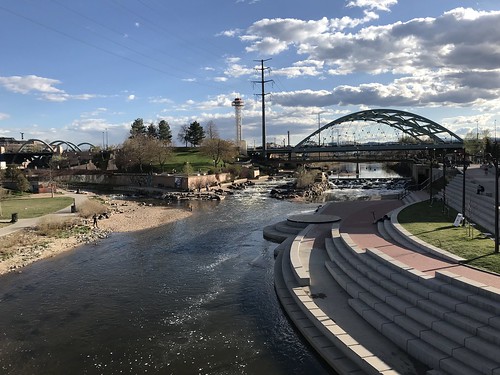
A short walk from Denver’s Union Station is an unusual pedestrian suspension bridge: Millennium Bridge. From certain angles it looks like the mast of a sailboat.
Millennium Bridge is tiny by suspension bridge standards, it only exists so people can walk across the train lines below. The unusual tilt in the tower is part of the design, accentuated by the fact that it’s dwarfed by significantly taller and straighter buildings on either side.

On top of the bridge the train lines are visible below. On one side the passenger trains serving Amtrak and regional trains are visible at the Union Station platforms. On the other you’re more likely to see freight trains.
The above photo shows two freight trains carrying coal. Not the cleanest source of power, though there’s a good chance that train will pass a wind farm or two on its way east.

Just across the bridge to the east is a series riverfront parks. These parks feature paved pathways for joggers and bicyclists, play areas for kids, and local wildlife. (Who knew that Denver has so many wild rabbits?)
One small section of the park is known as Confluence Park — the merge point of two natural water streams: the smaller Cherry Creek flows into the larger South Platte River.
Which brings us back to energy. Early western settlers had limited sources of energy, and one of them would have been water (think old wood waterwheels, not hydroelectric dams.) I don’t have much verifiable history here but supposedly waterwheels were built along the South Platte River in Denver.
It’s hard to imagine powering anything off such a modest river these days, though it might have made sense in an era when Denver was a small farming town with grain mills as the only consumer of energy.
